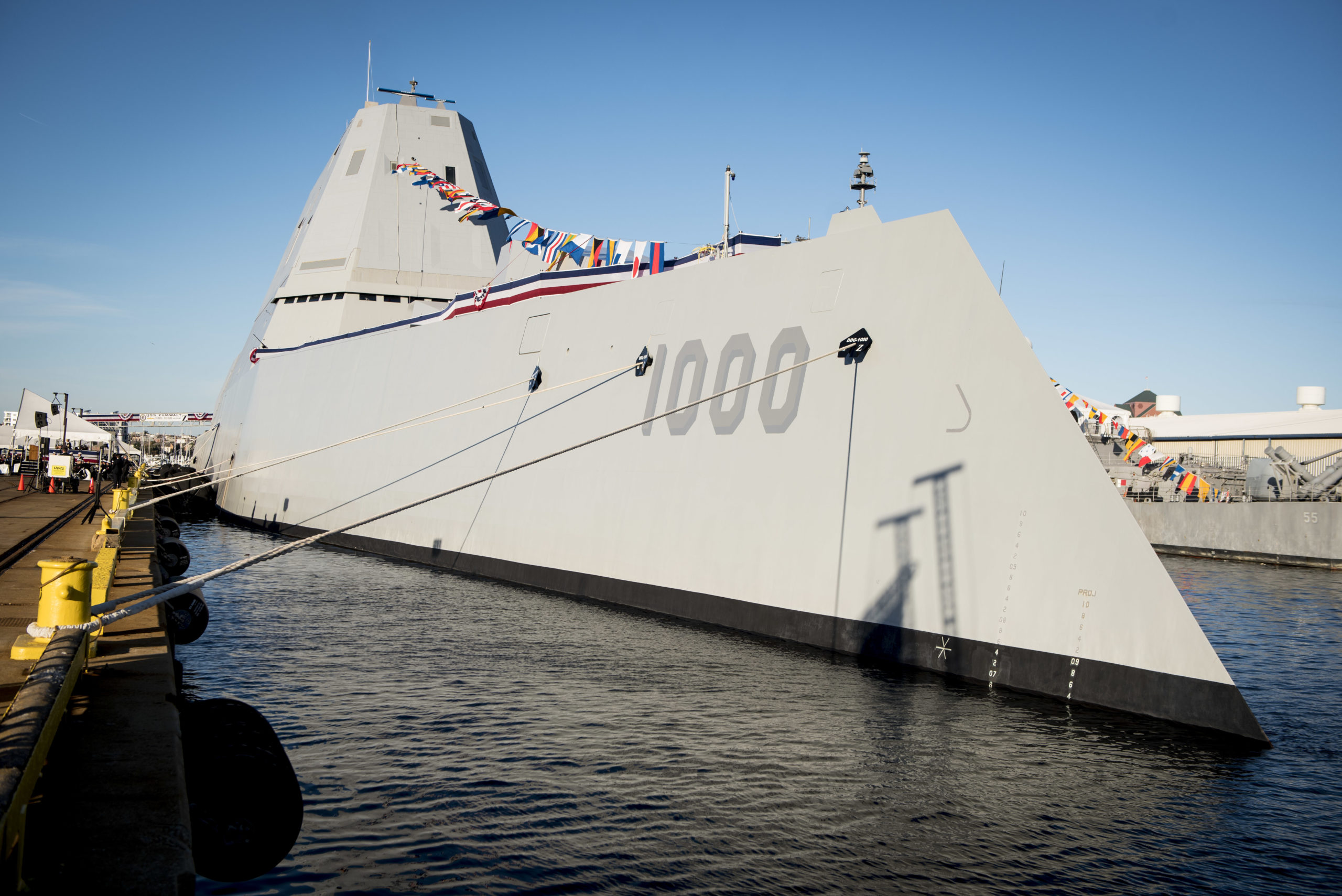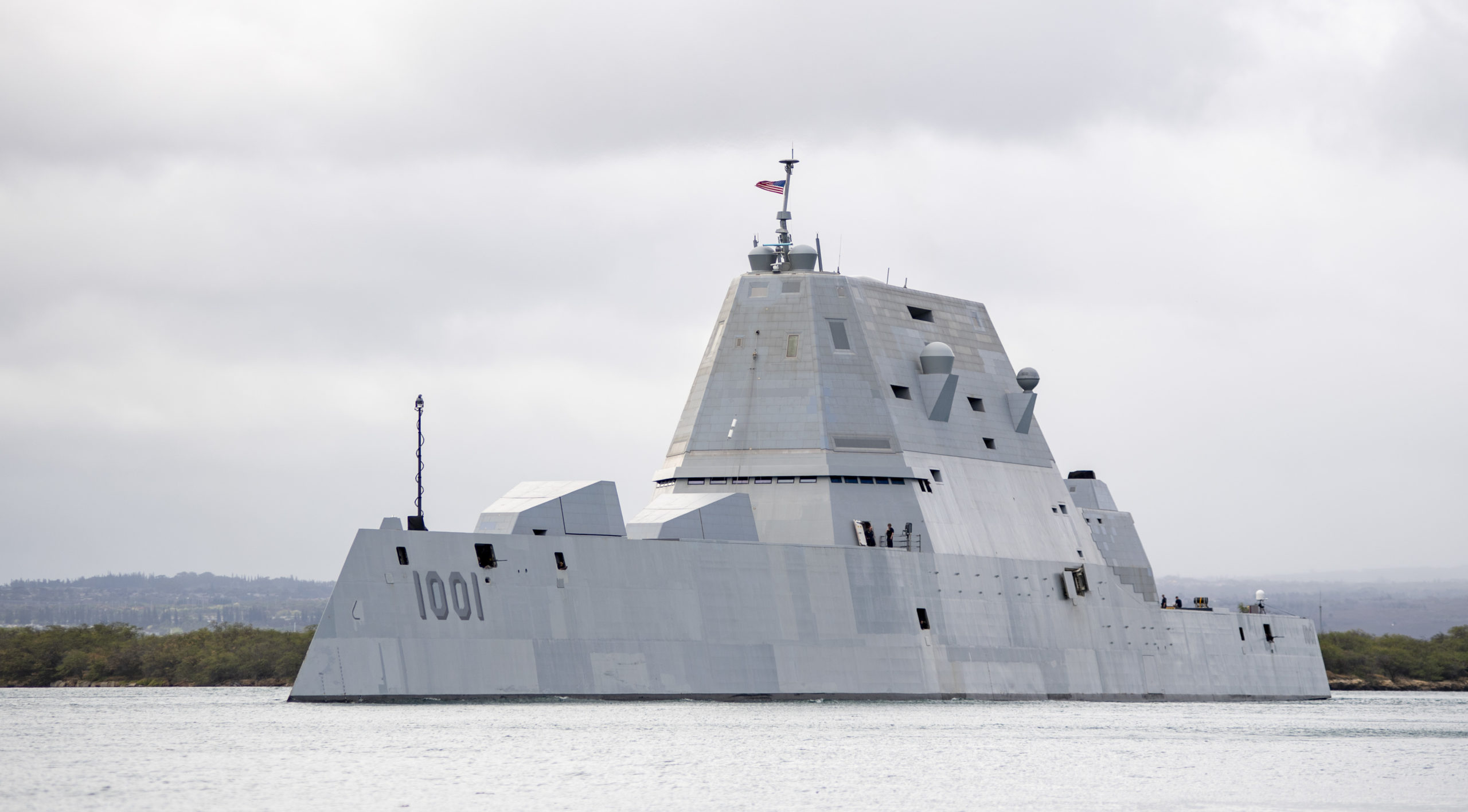To maintain naval superiority, the US Navy continues modernizing its fleet, particularly its aging surface combatant vessels, kickstarting its DD(X) program. Also known as the next-generation guided-missile destroyer, ships built under the program are set to succeed the remainder of Ticonderoga-class cruisers and Flight I/II of the Arleigh Burke-class destroyers equipped with advanced technology.
With its outlook design alone, the Zumwalt-class warships were billed as the Navy’s future stealth cruiser-sized super destroyers that would carry on America’s superiority in the world’s oceans and littorals for the next 50 years. The concept of the futuristic battleship expanded from the 1994 SC-21 program and went through heavy revisions and name changes before finally becoming what it is known today.
Following the CG(X) cancellation in 2010, the Navy pressed on to hunt for future successors to its aging fleet of battleships, eventually landing on the Zumwalt-class destroyers. And it underwent tons of back and forth, with the initially planned number of ships to be acquired from 32 to 16 to seven, and eventually announcing to settle for three units by 2009 and revert to building more Arleigh Burke-class instead. Mainly because of the high spending. Each destroyer reportedly costs over $4.2 billion—in construction costs alone.
Finally, work on the next-generation destroyers began, with the lead ship, the USS Zumwalt (DDG-1000), to be built by General Dynamics Bath Iron Works (BIW) in 2009. Zumwalt was delivered to the Navy with the activated combat system in 2020, making it the first full-electric power and propulsion ship. As planned, the destroyer featured advanced critical technologies, including a communication and intelligence system and an offensive strike missile. However, unlike its previous counterparts, the destroyer is set to provide support for land-attack to ground troops and carry out traditional missions of anti-air, anti-surface, and undersea warfare rather than countering deep-water threats.
The ship’s hull form is unique as it slopes inwards, significantly reducing the radar cross-section. It has a length of 610 feet (190 meters), a beam of 80.7 feet (24.6 meters), and a draft of 27.6 feet (8.4 meters), with a displacement of approximately 15,907 tons and a maximum speed of up to 30 knots. That’s about a hundred feet long and thirteen feet wider in size than Arleigh Burke-class destroyers. It is outfitted with an all-electric drive system with an integrated power system powered by a 78MW power station that includes two main turbine generators, two auxiliary turbine generators, and two 34.6MW advanced induction motors. It also featured an Integrated Full Electric Propulsion system that generates 72MW propulsion power and a 58MW backup from its all-electric propulsion. In 2007, the Rolls-Royce MT30 36MW gas turbine generator set was chosen to power the integrated power system.

For radar and sonar, each Zumwalt class destroyer has a combination of Lockheed Martin’s S-band volume search radar and Raytheon’s AN/SPY-3 multifunction radar X-band used to detect low-observable anti-ship cruise missiles. Meanwhile, the ship fitted Raytheon AN/SQQ-90 for its undersea warfare system and AN/SQS-60 hull-mounted mid-frequency sonar, AN/SQS-61 hull-mounted high-frequency sonar, and AN/SQR-20 multifunction towed array sonar and handling system.
Moving on to combat systems and weaponry, the Navy reportedly plans to replace some of the ship’s combat system equipment with Zumwalt Enterprise Upgrade Solution (ZEUS), “equipment more similar to, and interoperable with, combat system equipment on other US Navy surface combatants.” Another upgrade to the already costly ship.
The three-ship class is equipped with weapons optimized for littoral and network-centric warfare, mounting MK 57 vertical launch system (VLS) modules, RIM-162 Evolved Sea Sparrow Missiles (ESSM), 155 mm advanced gun system, and 30mm Mk 46 Mod 2 gun weapon system.
Each Zumwalt class destroyer has a crew of around 158, including an aviation detachment, and its flight deck and enclosed hangar can accommodate up to two medium-lift helicopters.
USS Zumwalt (DDG-1000)
Pax Propter Vim (“Peace Through Power”)
USS Zumwalt (DDG-1000) is the lead ship of her class and the first USN vessel to be named after decorated war veteran Admiral Elmo Russell “Bud” Zumwalt Jr, who notably served during the Vietnam War and later as the 19th (youngest) Chief of Naval Operations.
BIW began the construction of Zumwalt in February 2009 and had its keel-laying ceremony nearly three years later. It was launched in October 2013, and after extensive sea trials, the Navy finally accepted the ship in April 2020. Shortly following its arrival, the destroyer joined the US Pacific Fleet battle force and made its first port call in Guam last September at the end of her most extended voyage since commissioned.

Commissioned: October 2016 / Accepted in April 2020
Status: In active service
Homeport: San Diego, California
USS Michael Monsoor (DDG-1001)
I Will Defend
Named after Navy SEAL Medal of Honor recipient Master-at-Arms Second Class Michael Anthony Monsoor, USS Michael A. Monsoor (DDG-1001) is her class’s second new-generation destroyer ship. Her construction began seven months after the lead ship in 2009, had its keel authentication ceremony on May 2013, and was launched on June 2016.
Initially, the Navy chose to use an unusual two-part commissioning scheme for the first two Zumwalt-class destroyers, placing both under “in commission, special” status. However, amidst sea trials, the DDG-1001 encountered electrical troubles in December 2017, forcing the sip to return to the shipyard in Maine. She returned to sea shortly after, resuming its scheduled tests without affecting her expected delivery in March of the following year, and was commissioned by January 2019. Most recent activities of DDG-1001 include participation in the Rim of the Pacific Exercise (RIMPAC) 2022 alongside the Abraham Lincoln Carrier Strike Group in Hawaii.

Commissioned: January 2019 / Accepted TBA
Status: In commission, special
Homeport: San Diego, California
USS Lyndon B. Johnson (DDG-1002)
In Defense of Great Society
The third and final Zumwalt-class next-generation destroyers bear the namesake in honor of the 36th President of the United States, Lyndon B. Johnson, who also served in the Navy during World War II, a Silver Star recipient and a former commander of the Naval Reserve.
The construction of USS Lyndon B. Johnson (DDG-1002) began soon after the BIW received the building contract from the Navy in 2011, with her keel laid down in January 2017. She was christened on April 2019 by Johnson’s daughters, who also served as the ship’s sponsors. The third Zumwalt-class destroyer is undergoing sea trials and is expected to be delivered to the Navy by 2024.

Status: Under sea trials










COMMENTS
You must become a subscriber or login to view or post comments on this article.